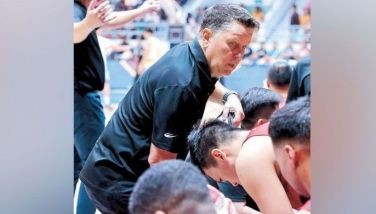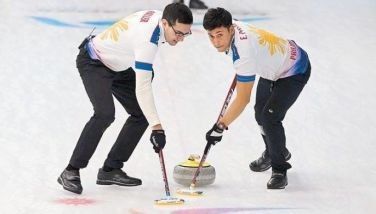Sports leaders should learn from World Bank project
May 30, 2006 | 12:00am
I have always believed that, when government funds are involved, emphasis must be placed on participation, the recreational aspects of sports, addressing issues related to access to sports by all sectors and value formation, rather than competition.
The logic behind this thinking is that public funds or taxpayers’ money are supposed to be used for the common good following the principle of the greatest good for the greatest number. John Rawls, the social justice philosopher put it another way when he said, "The greatest benefit to the least advantaged".
I have always felt that the private sector should take care of the competitive aspect of sports since this sector is almost always concerned with media values and exposure when it supports competitive or elite sports.
This was the main impetus behind my advocacy of a Master/Sector Plan for Philippine Sports that was put together when I was at the helm of the Philippine Sports Commission (PSC) from 1995 to 1998, halfway through the term of then President Fidel V. Ramos.
While the Plan was substantially completed after numerous public consultations, the Cabinet and the National Economic and Development Authority were not able to approve the said plan as a new government took over on July 1, 1998. Succeeding administrations of the PSC never really updated the Plan in a substantive way and ignored it totally.
The Plan could have opened up sports policy making to a wider sector thus producing innovative ideas that could help alleviate the chronic shortage of funds for Philippine sports. The issue then and now is not really the chronic shortage of funds (money has always not been enough for everything!) but the shortage of ideas on how to promote sports development, especially at the grassroots where all sustainable development emanates.
Such a plan could have triggered proposals from the non-government organizations (NGOs) and other stakeholders on how they can assist sports development through concrete projects that could have attracted funds exclusive of those coming from appropriations, the PCSO and Pagcor. It is to be noted that NGOs are experts at community organizing and getting excluded sectors to participate in development.
One such concrete project that could have emanated from the Plan would have been an exhibit encouraging innovative ideas from all sectors. Perhaps our sports leaders could learn a thing or two from the World Bank which has been sponsored, together with the governments of Australia, Canada and Japan, the Panibagong Paraan, twice since 2004.
For two days, Friday and Saturday, last week, the Megatrade Halls of SM Megamall played host to the Panibagong Paraan 2006 or the 2nd Philippine Development Innovation Marketplace.
The World Bank and these governments provide grant financing from P500,000 to P1 million for projects that promote development with equity. Specifically, these projects must, among others: present non-conventional approaches to addressing equity and development challenges and have the potential for scaling up (to cover a larger number of beneficiaries/wider geographic area or progress to a broader range of services/related activities) and for replication in another area given similar conditions.
Given the theme and one-year implementation period, such effects or benefits must be manifested in improvements in the inclusion/equity aspect. Potential benefits to the intended beneficiaries must be manifested in tangible benefits (in terms of access to services) and indications of how the project will contribute to broader equity/inclusion goals, that is, addressing root causes of the problems.
Out of the 900 or so projects submitted for consideration, 87 finalists were chosen. From this finalist list, 59 were chosen winners in a number of categories.
One such winner was the Culture Cooperative and Entrepreneurship Program for Rural Artists in Bulacan, a project of the De La Salle Professional Schools Graduate School of Business in partnership with the Artists Guild of Sta Maria (AGOS).
The culture cooperative is both about increasing incomes and building communities and culture. The project addresses limited access to financial resources and markets among rural artists, through cultural cooperativism, entrepreneurship, market development and micro credit. Cash and art savings become part of capital formation, making artwork bankable.
There were other fascinating and noteworthy projects: Voices of "Women in Conflict with the Law" on Access to Justice of the Institute of Human Rights of the UP Law Center; Center for Autism and Related Disorders, Phils; and the Municipal Tool Center.
Without doubt, putting together such a similar project by the sports community will go a long way in capacity building, generating and mobilizing resources and creating linkages and helping in the delivery of sports services at the community level. This can, however, happen only if sports leaders venture outside their comfort zones and think outside the box.
The logic behind this thinking is that public funds or taxpayers’ money are supposed to be used for the common good following the principle of the greatest good for the greatest number. John Rawls, the social justice philosopher put it another way when he said, "The greatest benefit to the least advantaged".
I have always felt that the private sector should take care of the competitive aspect of sports since this sector is almost always concerned with media values and exposure when it supports competitive or elite sports.
This was the main impetus behind my advocacy of a Master/Sector Plan for Philippine Sports that was put together when I was at the helm of the Philippine Sports Commission (PSC) from 1995 to 1998, halfway through the term of then President Fidel V. Ramos.
While the Plan was substantially completed after numerous public consultations, the Cabinet and the National Economic and Development Authority were not able to approve the said plan as a new government took over on July 1, 1998. Succeeding administrations of the PSC never really updated the Plan in a substantive way and ignored it totally.
The Plan could have opened up sports policy making to a wider sector thus producing innovative ideas that could help alleviate the chronic shortage of funds for Philippine sports. The issue then and now is not really the chronic shortage of funds (money has always not been enough for everything!) but the shortage of ideas on how to promote sports development, especially at the grassroots where all sustainable development emanates.
Such a plan could have triggered proposals from the non-government organizations (NGOs) and other stakeholders on how they can assist sports development through concrete projects that could have attracted funds exclusive of those coming from appropriations, the PCSO and Pagcor. It is to be noted that NGOs are experts at community organizing and getting excluded sectors to participate in development.
One such concrete project that could have emanated from the Plan would have been an exhibit encouraging innovative ideas from all sectors. Perhaps our sports leaders could learn a thing or two from the World Bank which has been sponsored, together with the governments of Australia, Canada and Japan, the Panibagong Paraan, twice since 2004.
For two days, Friday and Saturday, last week, the Megatrade Halls of SM Megamall played host to the Panibagong Paraan 2006 or the 2nd Philippine Development Innovation Marketplace.
The World Bank and these governments provide grant financing from P500,000 to P1 million for projects that promote development with equity. Specifically, these projects must, among others: present non-conventional approaches to addressing equity and development challenges and have the potential for scaling up (to cover a larger number of beneficiaries/wider geographic area or progress to a broader range of services/related activities) and for replication in another area given similar conditions.
Given the theme and one-year implementation period, such effects or benefits must be manifested in improvements in the inclusion/equity aspect. Potential benefits to the intended beneficiaries must be manifested in tangible benefits (in terms of access to services) and indications of how the project will contribute to broader equity/inclusion goals, that is, addressing root causes of the problems.
Out of the 900 or so projects submitted for consideration, 87 finalists were chosen. From this finalist list, 59 were chosen winners in a number of categories.
One such winner was the Culture Cooperative and Entrepreneurship Program for Rural Artists in Bulacan, a project of the De La Salle Professional Schools Graduate School of Business in partnership with the Artists Guild of Sta Maria (AGOS).
The culture cooperative is both about increasing incomes and building communities and culture. The project addresses limited access to financial resources and markets among rural artists, through cultural cooperativism, entrepreneurship, market development and micro credit. Cash and art savings become part of capital formation, making artwork bankable.
There were other fascinating and noteworthy projects: Voices of "Women in Conflict with the Law" on Access to Justice of the Institute of Human Rights of the UP Law Center; Center for Autism and Related Disorders, Phils; and the Municipal Tool Center.
Without doubt, putting together such a similar project by the sports community will go a long way in capacity building, generating and mobilizing resources and creating linkages and helping in the delivery of sports services at the community level. This can, however, happen only if sports leaders venture outside their comfort zones and think outside the box.
BrandSpace Articles
<
>
- Latest
- Trending
Trending
Latest
Trending
Latest
Recommended






























